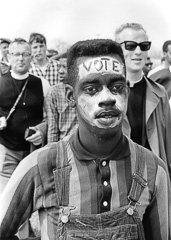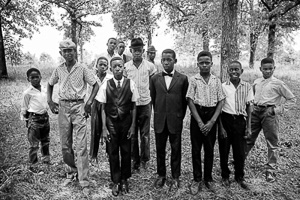Traveling Exhibitions
I'm Walkin' For My Freedom: The Selma March and Voting Rights

Vote! The Selma March
The Selma March was the largest and most significant march in civil rights history, and it led directly to passage of the Voting Rights Act of 1965. The Act mandated federal oversight of all US counties with a history of voter discrimination against African Americans, and it opened the door to voting for most Americans. Today the Act is under assault following a restrictive Supreme Court decision and the ensuing efforts of state legislators across the country to enact new laws requiring voter ID's and reducing voter registration periods.
To celebrate the Selma March and to offer teachers a tool for educating young people about their civil rights history and the importance of voting, Matt Herron, a noted civil rights photographer has created a special photographic exhibition documenting the March and the struggle for the right to vote. The show consists of 30 black and white photographs matted in 16” x 20” and 20” x 24” frames, with captions and explanatory wall labels. A teachers' guide is available. Here is a look at the photographs in sequence with their captions.
The show is designed to fit modest spaces such as small galleries, university centers and community places, and rents for a two month period for $3,000. For inquiries, please write to us.
CIVIL RIGHTS UNDER THREE HATS: The Photography of Matt Herron

Police Brutality, Jackson MS
As teachers of photography know, the work of photographers who prefer to capture human events, can be roughly classified according to three distinct styles: photojournalism, documentary photography, and photography as propaganda.
Photojournalists are concerned mostly with news events, and they usually try to picture these events with a certain degree pf objectivity. Documentary photographers focus on the web and fabric of ordinary life whether it be a migrant family in California's Central Valley or a jungle tribe living in the Amazon Basin. And like photojournalists, they attempt to picture their subjects without imposing a personal point of view. Photographers who support a particular cause use their pictures to propagate that cause. Their pictures are not objective, but as propaganda, they are not necessarily negative—it depends on the cause and the degree of transparency.

Rural Boys
Matt Herron covered the civil rights movement in the South during the Sixties as a photojournalist for the major news and picture magazines, but he also worked with The Student Non-Violent Coordinating Committee (SNCC), the primary civil rights organization in Mississippi, training photographers and photographing its projects and demonstrations. His pictures were used by SNCC to raise money and garner support among liberal groups in the North. And in 1964 he fielded a team of five documentary photographers that attempted to picture the process of social change evolving so rapidly during that conflicted period in the South.
He often thought of himself as wearing three photographic hats: journalism, propaganda and documentary. This exhibition attempts to clarify the three styles by separating his work according to its intention. The show can be a teaching tool for a photography program or may be viewed simply as an arresting collection of civil rights images. It consists of 30 black and white photographs matted in 16” x 20” frames, with captions and explanatory wall labels. For a look at the photographs in sequence with their captions, please visit Three Hats.
The show is designed to fit modest spaces such as small galleries, university centers and community places, and rents for a two month period for $3,000. For inquiries, please write to us.